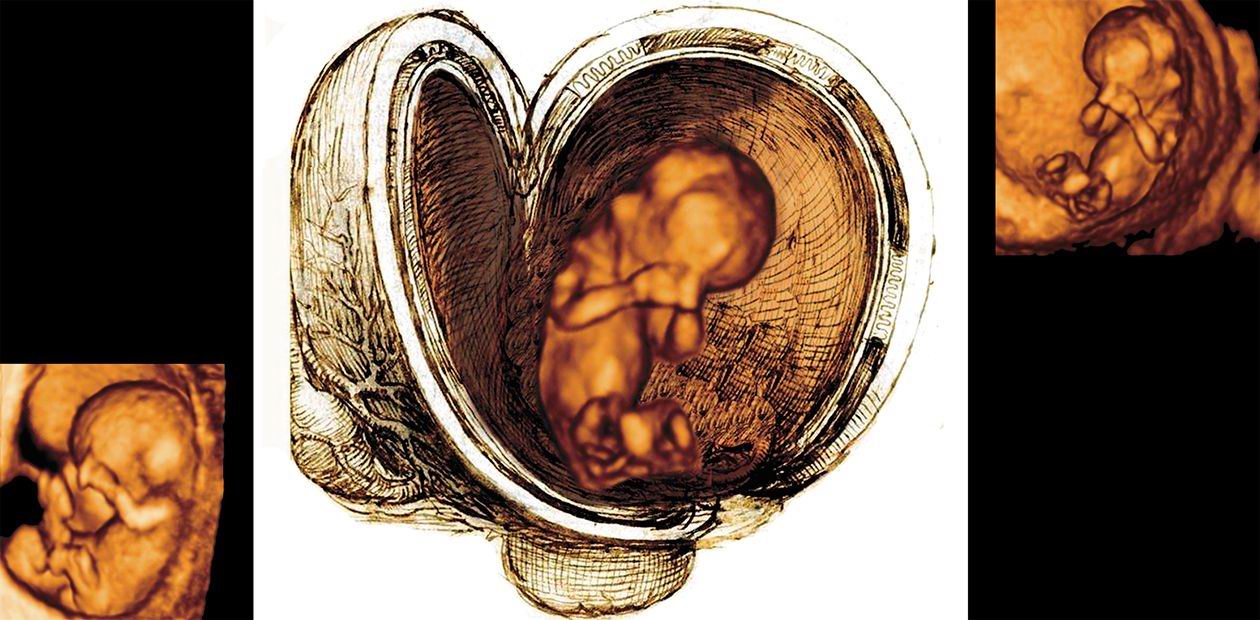To the «Star Gate». From Conception to Birth
Progress achieved in research technologies has to a large extent allowed discovering the mystery of animal and human life. This is also true for the antenatal life. And even though incredible, great processes and mechanisms of realization for an organism newly arrived in this world have largely remained unclear until now, already available information allows making certain generalizations. Scientific and practical interest in embryonic and impetus periods in the realization of living creatures, including man, is explained not only by the fact that the problem of reproduction is important, urgent and eternal but also by the fact that it touches upon problems of natural science, laws of preservation of species, and evolution. For man, it is also connected with searching for meaning of life, mystery of existence, and theology.
A materialist scientist cannot ignore the theological component of this subject if for no other reason than the direct and powerful impact religious concepts have on the reproduction of a person, ethnicity and civilization on the whole. It can be possible that an atheist has come into the world thanks to his/her religious ancestors. The world religions pay special attention to the antenatal period of life. All great prophets came to life from their mother’s womb but not in a fairylike way on the shining top of a sacred hill, even though there is no lack of the descriptions of miracles and miraculous events in different religions. Even Gods appear on earth, going through the birth channels of their mothers. Something very important indeed is happening during this period of fetal life, which cannot be called a purely technical interval in the process of creating a new living creature
“Turn in wonder to God’s wisdom, which arranged it this way. Since amazement at great objects does not diminish when it has been discovered how something extraordinary happened”.
St. Basil the Great
The First Talk on Shestodnev
…Uterine cavity, twins. One fetus asks the other one in reverie:
“Do you think it is good out there?”
“Don’t know. Nobody has ever returned from ‘there’ yet.”
Anecdote
Progress achieved in research technologies has to a large extent allowed discovering the mystery of animal and human life. This is also true for the antenatal life. And even though incredible, great processes and mechanisms of realization for an organism newly arrived in this world have largely remained unclear until now, already available information allows making certain generalizations.
Scientific and practical interest in embryonic and impetus periods in the realization of living creatures, including man, is explained not only by the fact that the problem of reproduction is important, urgent and eternal but also by the fact that it touches upon problems of natural science, laws of preservation of species, and evolution. For man, it is also connected with searching for meaning of life, mystery of existence, and theology.
A materialist scientist cannot ignore the theological component of this subject if for no other reason than the direct and powerful impact religious concepts have on the reproduction of a person, ethnicity and civilization on the whole. It can be possible that an atheist has come into the world thanks to his/her religious ancestors.
The world religions pay special attention to the antenatal period of life. All great prophets came to life from their mother’s womb but not in a fairylike way on the shining top of a sacred hill, even though there is no lack of the descriptions of miracles and miraculous events in different religions. Even Gods appear on earth, going through the birth channels of their mothers.
Something very important indeed is happening during this period of fetal life, which cannot be called a purely technical interval in the process of creating a new living creature.
Through the uterine tubes
The embryonic and fetal periods of human life, from fertilization to birth, last approximately 273 days if the pregnancy proceeds in a regular fashion. Seven days pass from syngamy in the ovarian (uterine) tube until the implantation of a newly formed organism.
Already at this stage, the embryo can encounter many dangers. Similarly to an aircraft’s flight, the major difficulties for the conceived man arise during “taking off” and “landing”, especially the former. It is true for the techniques of artificial fertilization too.
Troubles can start already during the fusion of the genetic material. Genetic program failure can lead not only to chromosome aberrations, i.e., mutations or violations in the chromosome structure, but also to a change in the number of chromosomes. A large portion of embryonic material with chromosomal failure cannot realize itself because of severe defects in the developmental mechanisms, while some fetuses happen to be unviable after birth.
So-called early embryonic losses are indeed often connected with chromosome aberrations. Unfortunately, dangers associated with the beginning of human life are not limited to chromosomal problems. A uterine tube is a thin tunnel 100—150 mm in length which can become an insurmountable obstacle on the way of the blastocyst; then the pregnancy becomes abdominal, i.e., it finds itself beyond the life limits. Symptoms of abdominal pregnancy are diagnosed in 15 % of pregnant women, thus they will remain under special supervision for a certain period of time.
Approximately until the 18th day of the ovum development, pregnancy can be recorded only biochemically: it is impossible to determine its localization during this period. When the value of chorionic gonadotropin in woman’s blood reaches 1500 mE/l, the ovum can already be detected in the uterus. Both falsely positive and falsely negative mistakes in diagnosing pregnancy localization lead to an inevitable chain of embryonic losses.
Inflammatory diseases of the uterine tube, such as chlamydial infection or gonorrhea, surgery on the organs of the abdominal cavity, abortion and even smoking constitute the major risk factors leading to abdominal pregnancy. If in a population as a whole abdominal pregnancies constitute 2 % on average, among smoking women this figure is five times higher.
Successful “landing”
Having reached the uterine cavity, the embryos can find themselves in unfavorable conditions. There exists a notion of an implantation window, a period from approximately the fifth to the seventh day of fertilization, when the embryo must “land” on a special implantation pad prepared for it in the mucous membrane of the uterine cavity. However, the place of landing can turn out to be unsuitable for the reception of the traveler.
Endocrine violations, abortion, inflammatory processes, toxic and medicinal influence, and stress as well as many other factors influence considerably the condition of the implantation pads in the womb. It has been experimentally proven that in female rats the number of active implantation places drops dramatically (from 8—10 to 1—2) after a sharp inflammation in the uterine cavity (Borodin et al, 2006).
Only a fifth of human fetuses has a chance to complete successfully their intrauterine developmentThose embryos which were lucky to get attached to the uterus can face some “unnatural” dangers, such as different kinds and variants of pharmaceutical and surgical termination of pregnancy. The bitter truth is that abortion is the Russian means of contraception. In Russia, the correlation between the number of births and artificially interrupted pregnancies remains depressingly high at 1:2.
Abortion. Figuratively speaking, abortion is a “spit into the star gate.” Let the materialist not like religious arguments about the inadmissibility of murder of a not yet born but already existing child, but actually everything is rather simple. Let us consider just one materialistic aspect of abortion, a breakdown in the “star gate” mechanism, which is usually not discussed by the believers and the clergy.
The thing is that there exist remnants of embryonic channels in the uterine body which sometimes do not close for various reasons. Under this condition, drifts lined with endometrium stretch from the uterine cavity into the depths of muscular tissue. It is the case of internal endometriosis, or adenomiosis. According to various data, this condition characterizes from 10 to 90% of women, with the average figure making up one fifth of female population.
An instrumental abortion, similarly to any other uterine inflammation, “locks” the vent doors of these channels. With this, a drainable form of endometriosis, a comparatively harmless condition of the uterine body, passes into the nondrainable form. From this moment on, against the laws of nature, the uterus menstruates into the muscle, i.e., in itself, which results in its irreversible damage. As a result, the child bearing becomes highly doubtful.
Inflammations, abortions, and smoking pose a serious threat both to the conceived embryos and to the possibility of pregnancy itself. This is one of the major reasons why infertile couples appear. It is amply evident that under conditions of worsening demographic situation even smoking must be treated by the society as asocial behavior.
In the aquatic world
Some embryos manage to overcome all the abovementioned obstacles and become fetuses (the fetal period starts from the 12th obstetrical week or from the 10th week of the embryonic development). The fetus is located in the amniotic cavity filled with the amniotic multifunctional water of unique composition.
The fetus is growing by the hour. Sleep time alternates with wake time. Our internal timekeeping is amazing: man is able to alternate sleep and wake time in strict order even in the absence of precise time signals. According to some researchers, the pattern of circadian rhythms is established in the first years of life and stays quite stable throughout the rest of it. According to others, man possesses a biological clock set in a certain way from the beginning. The researchers have studied the daily rhythm of cordial and motor activity in the fetus at the early stages of its development (16-28th obstetrical weeks) (Zarnadze, Kintraya, 2002). It has been discovered that the little person’s life cannot be called quiet. During the night sleep of the pregnant woman (from 10 pm till 4.30 am, for example), 1000 fetal movements were recorded. At the same time, during its active period the fetus remained comparatively quiet until 8 am, having made 236 movements only.In such a manner, during the day the fetus goes through the periods of high and low activity of physiological functions; however, the rhythm of these changes does not agree with that of its mother. It is obvious that at the 16th week of pregnancy the fetus already has its own biological clock thanks to which the necessary homeostasis (the tendency to maintain internal stability in an organism is probably maintained)
During this period, many organs and systems have been formed in the embryo and the system of blood formation has been initiated. The heart working continuously with the rhythm of 140—180 contractions per minute is going through the adjustment process. When the fetal size reaches the size of 50—60 mm (12 weeks), cardio—vascular system provides a constant blood flow from placenta to the embryo’s organs at a speed of up to 0.5 m/sec. At the time of birth the fetus’s heart pumps up to three liters of blood per minute.
Now, the aqueous medium is one of the realities providing vital functions of the fetus. The little amphibian can move very well, with its movements felt by the pregnant woman starting from the 18th—20th obstetrical week. The fetus swallows the water, drawing it in with the help of the breathing system, irrigating the bronchi. A complete change of water takes approximately 2 hours, so that the embryo’s receptacle presents a well-“aired” place.
No matter how tight the bond between the fetus’s and the mother’s body is, in many ways the former is already an independent creature with its own life and character. The fetus’s antenatal life can be tracked using many different methods, including biochemical, serological, cytogenetical, eletrocardiotomographic, magnetic resonance tomography, amnioscopy, and even roentgenologic. At present, the ultrasound method is considered to be the most visual. Having incorporated numerous discoveries in physics and electronic technologies, the last generation ultrasound scanners literally allow looking into the face of a not yet born man.
The very first “emergency”
Examples illustrating the specificity of fetal physiology show how complex the processes of intrauterine development are. The little man we call a fetus has to travel this path, which can be beset with problems, all on his own.
Without doubt, the future mother does a lot to protect her infant. Physiological changes in a pregnant woman are in the first place aimed at the fetus receiving everything necessary for it to develop. However, the pregnant woman herself can fall ill or suffer from different chronic diseases preventing the pregnancy from progressing in a regular fashion. Modern methods of clinical research help to evaluate the fetus’s condition and hear its calls for help by barely traceable signals.
Providing such help constitutes a major direction in prenatal medicine. Nowadays, many women reject prenatal diagnostics and/or fetus treatment considering it to be harmful for the future baby. But in many ways it is not very much different from refusing to help a grownup person. Modern interference in and correction of intrauterine development allows avoiding not only embryonic loss but also future disabilities.
It is very difficult to diagnose pathology in a newly born child. Half of success rests on establishing the correct diagnosis because many pathological conditions require urgent help. Modern technologies allow determining the cause of the trouble and getting ready to the birth of such a fetus.
One of the brightest examples of helping a fetus before its birth is the treatment of feto—fetal transfusion syndrome. This pathology, characteristic of enzygotic twins, results in failures in blood distribution between the fetuses. As a result, both fetuses suffer, one from a lack of blood and the other one from its excess. These failures cannot be prevented; however, they can be diagnosed and corrected, or else both babies can be lost. The treatment consists in breaking the vessel “bridges” between the fetal blood systems and is made endoscopically, with the vessels being cauterized with the laser. In case of a moderate pathology, a simpler interference is possible, which consists in increasing the uterine blood flow by removing some of the water.
Prenatal medicine providing medical help to not yet born infants is one of the most important subdivisions of clinical medicine, which deals not only with personal family matters but also with important state problemsAnother characteristic example is a “rhesus conflict”, an immune conflict, which develops in rhesus negative women in case of a second pregnancy with rhesus positive fetuses. The thing is that fetal erythrocytes can carry antigens (substances which can provoke immune response) the future mother does not have. (The baby gets them from its father.) As a result, fetal erythrocytes penetrate into the blood flow of the pregnant woman and may immunize her. During the second pregnancy with a rhesus positive fetus, the future mother generates protective substances, antibodies, which penetrate into the fetus and destroy its erythrocytes. This process can be so powerful that the fetus may lose most of its erythrocytes, develop all kinds of metabolic disorders and a hyposacra. As a result, the fetus can die. The treatment that allows giving normal birth consists in intrauterine blood transmission to the fetus.
There is no other way: even before his birth, a little man should be helped to enter this complex and complicated but wonderful world.
Wе are all fed up with discussing the demographic situation in Russia. Does it really matter now, when the price of oil is decreasing and the world financial crisis is developing? Meanwhile, in Israel, where the demographic problem is as acute as in Russia, the number of in vitro fertilizations (IVF) is 10 times higher (300 per 100,000 people annually) than in the USA, an economic and political flag post of the western world.
In Israel, the state system provides free services to infertile families until the birth of the third child. If a family wants to have more children, they only have to pay for the necessary medication.
According to different assessments, up to one fifth of family couples in Russia is infertile. These people do not need social security payments or fruitless promises, but free, state-guaranteed access to the modern auxiliary reproductive technologies. Despite the fact that the state still does not consider this 20 % to be a serious potential for a demographic growth, it is the force which can change the situation for the better and provide the dominance of those coming from the “star gates” over those departing.
References
Makogon A. V., Andryushina I. V. Obstetrical tactics to deal with umbelical cord artery thrombosis. Ultrasound and functional diagnostics, iss. 5, 2008, pp. 12—18.
Shevela A. I., Makhotin A. A. New technologies in solving the demographic problems. National projects, iss. 2, 2006, pp. 44—47.










